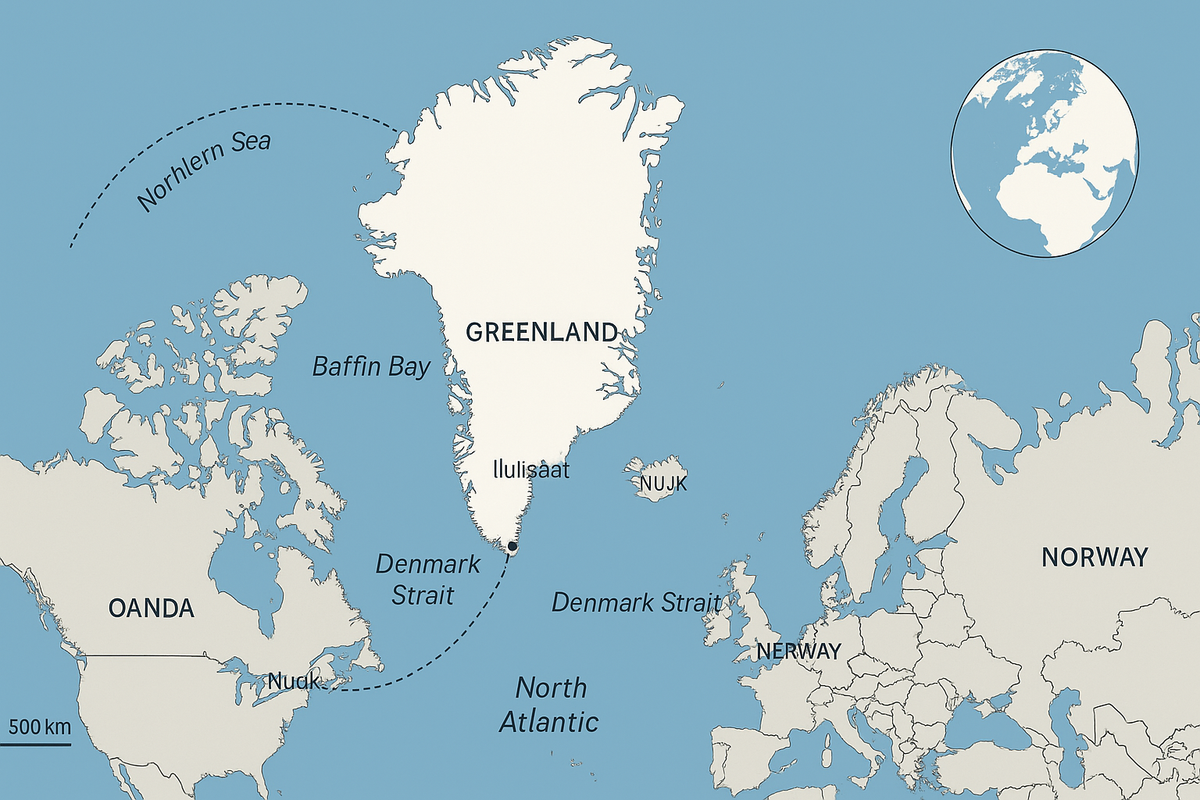Trump’s Greenland Gambit, Revisited
Donald Trump didn’t invent American interest in Greenland, but he did put it on billboards.

Donald Trump didn’t invent American interest in Greenland, but he did put it on billboards. In August 2019, after Danish leaders called the idea of selling the island “absurd,” he canceled a planned state visit and posted the now-famous meme—“I promise not to do this to Greenland”—over a photoshopped Trump Tower jutting from a colorful coastal town. The theatrics were pure Trump; the target was not. Greenland sits on the seam between North America and Eurasia, with critical minerals underfoot and the U.S. military’s northernmost base at Pituffik guarding the polar approach. That mix of spectacle and strategic logic is the through-line of Trump’s Greenland story. (Reuters, The Guardian)
What 2019 actually changed was not a land deal—there wasn’t one—but the political weather. Before the spat, Greenland’s foreign-policy file already mattered to Washington: sea-route access as ice retreats, missile early-warning at Pituffik (formerly Thule), and the island’s role in great-power competition. After the spat, everything ran hotter. The U.S. reopened its consulate in Nuuk for the first time since 1953 (June 10, 2020) and rolled out a $12.1 million economic package framed as deepening ties and—less subtly—countering Chinese and Russian influence. (U.S. Department of State, dk.usembassy.gov, Voice of America, ABC News)
Pituffik Space Base. The installation hosts the 12th Space Warning Squadron’s phased-array radar and satellite control assets, anchoring U.S. missile warning, missile defense, and space surveillance at the very top of the world. Geography makes it irreplaceable: polar trajectories over the Arctic make early detection a Greenland story as much as an Alaska one. (It’s also one of the most remote, unforgiving posts the U.S. operates.) (Peterson Schriever Space Force Base, buckley.spaceforce.mil)
Next, minerals and supply chains. Greenland’s south holds the Kvanefjeld/Kuannersuit deposit—long touted as a potential world-class rare-earths source. In 2021, however, Greenland’s parliament banned uranium mining, effectively freezing the project because its ore contains uranium as a byproduct. That put a major asterisk on any quick “resource win” and underscored a political reality: development paths are Greenland’s to choose, not Washington’s. (Reuters, The Library of Congress)
China factor. In 2018, a Chinese state-owned builder bid to help expand Greenland’s airports. The proposal was not a formally designated Belt and Road (BRI) project, but it clearly tracked with Beijing’s “Polar Silk Road” (the Arctic strand of BRI) outlined in China’s 2018 Arctic White Paper—encouraging state firms to pursue Arctic infrastructure tied to shipping and resource access. Copenhagen, with quiet allied backing, moved to keep Beijing out, underscoring how finance choices intersect with security.
All of that context collided with Trump’s personal style in 2019. When Denmark’s prime minister, Mette Frederiksen, labeled the sale idea “absurd,” Trump scrapped the Copenhagen trip and kept talking about Greenland’s strategic value. The splash mattered in two ways: it strained ties with a close NATO ally and pushed Greenland into U.S. domestic politics as a kind of geopolitical prop. The meme made the front pages, but the policy consequences were quieter and more durable—more American diplomats in Nuuk, more money, more attention. (Reuters, The Guardian)
Zoom out to the Arctic Council, the region’s consensus-based forum for cooperation on environment and sustainable development (not security). In May 2019, the ministerial in Rovaniemi ended without a joint declaration for the first time since the Council’s founding; the U.S. balked at climate language, and the Finnish chair issued a weaker “chair’s statement.” That mattered for tone: allies heard Washington leaning from climate and science toward hard competition (Pompeo’s speech that week was explicit about China and Russia), which is a poor fit for a forum that studiously excludes military security. The friction didn’t change Council rules—but it colored every Arctic conversation afterward. (Axios, oaarchive.arctic-council.org)
From 2020 on, U.S. engagement took on a steadier, less memetic shape. The consulate gave Washington a daily presence; the aid package funded education, energy, and entrepreneurship; and American officials spoke more openly about critical minerals and supply-chain security. Meanwhile, Greenlandic politics moved too: a new government rode in part on environmental concerns about uranium and halted Kvanefjeld. If Trump’s 2019 moment made Greenland impossible to ignore, Greenlanders used that spotlight to assert their own priorities. (U.S. Department of State, Voice of America, Reuters)
Legally, the “Can you buy Greenland?” question is almost beside the point. Under the 2009 Self-Government Act, the people of Greenland are recognized as a people with the right of self-determination. Independence is a defined process—via referendum and negotiated transition—not a transaction between Washington and Copenhagen. Denmark’s own official materials state this plainly, and both Denmark and Greenland repeated it in 2019. Put simply: there’s no market listing for a nation’s future. (STM English)
Fast-forward to 2025 and the story flares again, this time through allegations of influence operations. In late August, Denmark’s foreign minister summoned the top U.S. diplomat in Copenhagen after national broadcaster DR reported that Americans with ties to Trump had tried to shape public opinion in Greenland—especially on independence. The U.S. reaffirmed support for Greenland’s right to self-determination and stressed it doesn’t direct private citizens, while declining to discuss intelligence matters. Whether these reports harden into legal cases or fade into the fog of politics, the effect is the same: trust gets harder, and every meeting starts with a question mark. (Reuters, AP News)
So how should we read Trump’s Greenland? As a Venn diagram with three overlapping circles:
-
Real strategy. Pituffik’s radar and tracking missions underpin continental defense; sea routes and space surveillance run over the pole; critical minerals are a long game. Any U.S. administration would care about those, and allies know it. (Peterson Schriever Space Force Base, buckley.spaceforce.mil)
-
Domestic spectacle. The 2019 cancellation and meme turned a sovereignty question into a culture-war storyline: bold negotiator vs. stuffy Europeans. That grabs attention but narrows space for the quiet work that Arctic cooperation needs. (Reuters, The Guardian)
-
Local agency. Greenland isn’t a chessboard square. Voters constrained uranium mining; leaders decide who builds airports; the Self-Government Act sets the rules for any future status change. U.S. and Danish policy only “works” in Greenland if it works with Greenland. (Reuters, Alliance For Securing Democracy, STM English)
A last note on the Council vs. the climate of relations. The Arctic Council still runs on consensus and avoids security topics; nothing Trump did rewrote that mandate. But words and atmospherics matter in small-club diplomacy. In 2019, the absence of a declaration and the sharper talk about great-power rivalry signaled a turn that partners noticed—and that set expectations for how Washington would show up across the Arctic system, Greenland included. (Axios, oaarchive.arctic-council.org)
Bottom line: Trump’s Greenland push wasn’t a policy program so much as a pressure campaign where symbolism (a canceled visit, a gold tower meme) sat on top of enduring strategic interests (Pituffik, minerals, routes). It didn’t alter the Arctic Council’s remit or Greenland’s legal pathway to independence. It did amplify attention, accelerate U.S. presence, and—by 2025—tangle the issue with allegations that risk making cooperation harder than it needs to be. For a place where everything takes longer—the logistics, the weather, the politics—that’s not a trivial cost. (U.S. Department of State, Voice of America, Reuters)
Timeline — Trump, Greenland & the Arctic context
- Jan 26, 2018 — “Polar Silk Road.” China’s Arctic White Paper encourages state firms to pursue Arctic infrastructure as part of a Polar Silk Road.
- 2018–Jun 2019 — Airport bid (not formally BRI). A Chinese SOE advanced in Greenland airport tenders; it wasn’t an officially designated BRI project, but it aligned with Beijing’s Polar Silk Road push[1]. The bid was later withdrawn and Copenhagen kept Beijing out.
- May 7, 2019 — Arctic Council rupture. The Rovaniemi ministerial produced no joint declaration for the first time; Pompeo’s speech leaned into great-power competition.
- Aug 20–21, 2019 — The cancelation & the meme. After Denmark’s PM called a sale “absurd,” Trump canceled his Denmark visit and posted “I promise not to do this to Greenland.”
- Apr 23, 2020 — $12.1M package. The U.S. announced economic support for Greenland (education, energy, entrepreneurship).
- Jun 10, 2020 — Consulate reopens. The U.S. reopened the consulate in Nuuk (first since 1953).
- Nov 10, 2021 — Uranium ban. Greenland banned uranium mining, stalling the Kvanefjeld/Kuannersuit rare-earth project.
- Feb 11, 2025 — Repeal debate. A proposal to roll back parts of the ban resurfaced, which could revive Kvanefjeld.
- Aug 27–28, 2025 — New friction. Denmark summoned the U.S. envoy over alleged U.S.-linked influence ops in Greenland; Washington reiterated support for self-determination.
- Legal frame (2009→). Greenland’s Self-Government Act recognizes Greenlanders’ right to self-determination and outlines a referendum-led path to independence—so “buying” isn’t how status changes happen.
Further reading:
- China’s Arctic Policy (2018 White Paper)
- CSIS — “China Launches the Polar Silk Road” (2018)
- Reuters — “Greenland courting Chinese investors for airports” (Mar 22, 2018)
- Reuters — “China withdraws bid for Greenland airport projects” (Jun 4, 2019)
Polar Silk Road is the Arctic strand of China’s Belt and Road vision from its 2018 Arctic White Paper. Denmark never treated the 2018 airport proposal as an official BRI project; it simply aligned with Polar Silk Road aims (Arctic infrastructure tied to shipping/resource access). ↩︎
